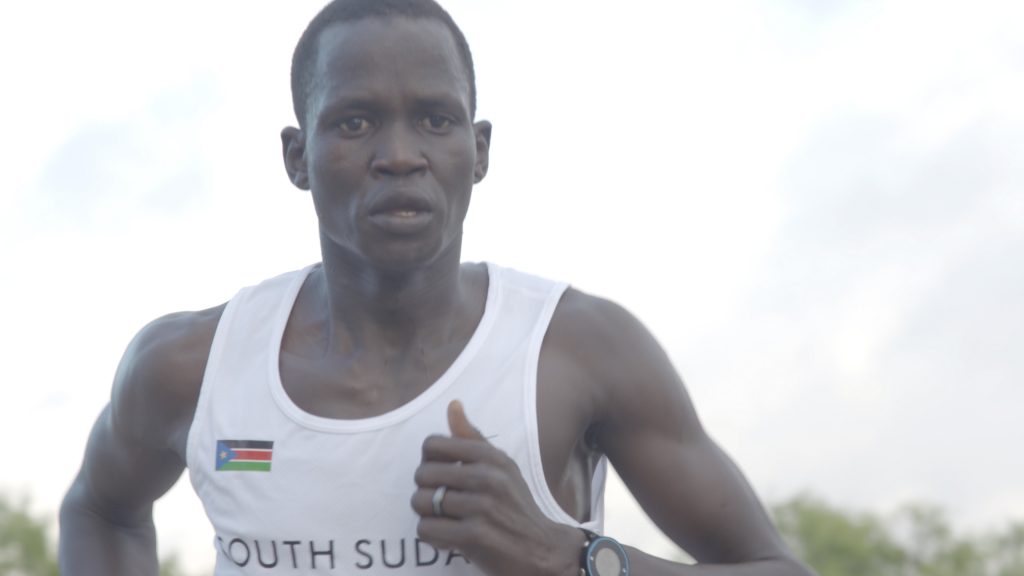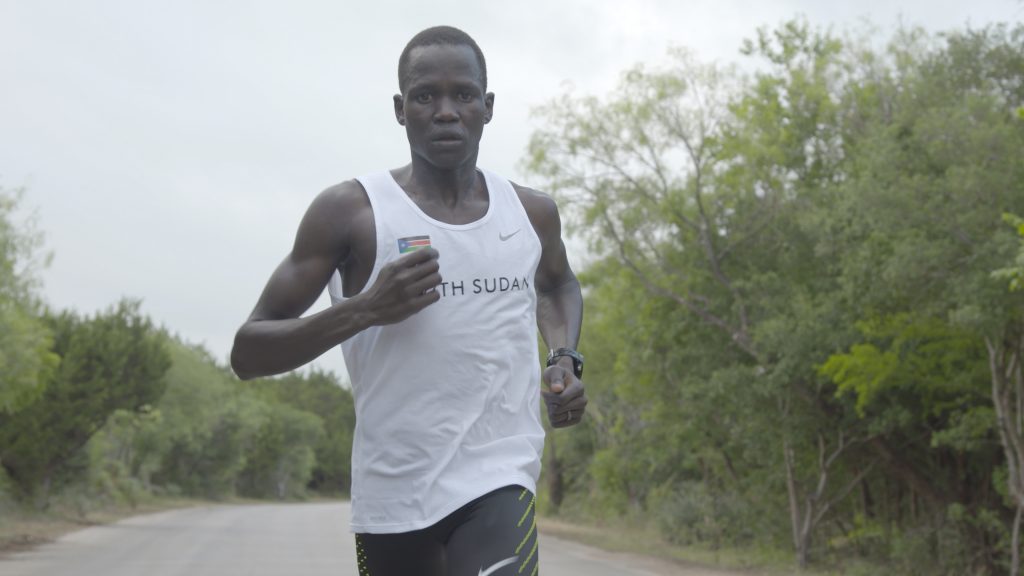January 28, 2021
by Carla Hay

Directed by Remi Weekes
Some language in Sudanese with subtitles
Culture Representation: Taking place in England and in South Sudan, the horror flick “His House” features a predominantly black cast of characters (with some white and Latino people) representing the working-class and middle-class.
Culture Clash: A refugee husband and wife flee from war-torn South Sudan to England but find a different kind of horror in their new home.
Culture Audience: “His House” will appeal primarily to people who are interested in horror movies that are more about dark psychological issues and society oppressions than bloody gore.

At first, the horror movie “His House” might appear to be a standard horror flick about a haunted house. There’s the surface-level plot that is common in movies with haunted house movies : A married couple moves into a new home, which is plagued by spirits that cause terror. But “His House” (the feature-film debut of writer/director Remi Weekes) delves much deeper than just the protagonists’ usual dilemma about what to do about the ghosts. It’s also a blistering meditation on trauma, both self-inflicted and that which is imposed by society.
In the beginning of “His House,” married couple Bol Majur (played by Ṣọpẹ Dìrísù) and Rial Majur (played by Wunmi Mosaku) are shown fleeing their native South Sudan by boat with other war refugees. They land in an unnamed part of England, but are quickly detained by immigration authorities. Bol and Rial are told by a condescending immigration official Mark Essworth (played by Matt Smith) that they will be freed from detention under certain conditions. “This is bail … not citizenship,” Mark tells the couple.
In exchange for their freedom, Bol and Rial are placed in a run-down housing development, where they are assigned a nearly empty house that’s also in a state of disrepair. The U.K. government has also assigned jobs to Bol and Rial, as a condition for the couple not to be deported. Living in the house comes with strict government rules: No guests, no smoking and no candles.
Mark tells Bol and Rial that they should feel lucky because this house is much larger than what the government gives to an undocumented immigrant couple. Rial is immediately suspicious. “Why are we so special?” she asks Mark. He replies, “You must’ve hit the jackpot.”
Bol and Rial try to make the best of the situation by looking at this new chapter in their lives with a positive attitude. Rial comments, “We will be new here.” Bol adds, “Born again.” However, it’s hard to overlook that the one-bedroom house is such a dump. It’s dirty, the wallpaper and paint are peeling, and the house’s electrical connections don’t always seem to work properly.
During the couple’s first night in the house, it becomes immediately apparent that things aren’t quite right there. Bol hears the sound of someone humming and then rustling sounds. And then, a bat flies through a hole in the wall after he sees a vision of Rial on the floor.
The area around the house is desolate and bleak. The neighbors keep to themselves, and so do Bol and Rial. The movie gives a slight feeling of disorientation when Bol visits a barber and asks him if they’re in London. And the barber gives a strange answer: “Why not?”
As time goes on, Bol and then Rial start to see frightening visions of people in the house. Sometimes the people appear to be hiding between the walls, while other times the people appear in the same rooms. During one startling incident, Bol finds behind peeling wallpaper that there’s a long rope attached to seaweed. He then sees a blonde girl doll, which a mysterious hand then quickly grabs and pulls back into the abyss.
Bol and Rial are terrified to tell people what they’re seeing in the house, because they don’t want to risk looking like crazy immigrants. If they report the house as haunted, they could be even more at risk for being deported. And they can’t move from the house, as per government rules that Bol and Ral agreed to, in order to avoid being deported. The best that Bol and Rial can do is report that the house is experiencing electrical problems, with the hope that government officials who come to inspect can possibly find the root of the problem.
As part of their government-sanctioned asylum, Bol and Rial get medical checkups. During Rial’s visit with a doctor, she explains why she has unusual marks on her body: While in South Sudan, she marked herself with the signs of both warring tribes so that she wouldn’t get killed. The idea was to confuse any possible captors about which was her real tribe. Later in the story, it’s revealed that before fleeing to England, Rial watched her entire family in South Sudan get murdered during a brutal massacre.
The rest of “Our House” gradually uncovers more layers to the story, and the details won’t be revealed in this review. However, it’s enough to say that there’s a family curse and a dead daughter that have a lot do with why Bol and Rial might be haunted by the spirits who inhabit the house. And certain characters aren’t necessarily who they first appear to be.
“His House” also has the added depth of being an immigrant story of people who are in a foreign country that they both admire and fear. In movies about haunted houses, the people being plagued by these ghosts are usually there of their own free will and won’t move because they’ve got too much invested financially in staying in the house. “His House” flips that typical narrative by making it a movie about people essentially forced to live in a haunted house, on orders of a government. This immigrant couple was seeking freedom in another country, but the irony is that in this new country, this husband and wife have essentially held captive by a government which is controlling their lives.
The movie is also about how trauma can be its own kind of prison. At various points in the story, viewers are left to wonder what might be “real” and what might be a hallucination. And as the visions get more threatening and oppressive, Bo and Rial have different ways of handling everything. “His House” plays guessing games about who might be more mentally unbalanced: Bo or Rial?
“His House” writer/director Weekes brings a “slow burn” terror to the story that has enough scares to make it a genuine horror movie. The movie does not get bogged down in too much bloody gore, which is the direction that many other movies of this type might go. Even though the house is dilapidated, Weekes brings almost a stylish gloom to the atmosphere when the ghosts appear.
“His House” is also not a typical haunted house movie where, one by one, people get killed in the house, because the Majurs are very much isolated in their new home. Dìrísù and Mosaku turn in admirable performances, especially when more of this couple’s background is revealed. The movie’s acting is effective, but the story’s real impact comes from the lingering feeling that people can move to different places, but they can’t really escape from emotional baggage.
Netflix premiered “His House” on October 30, 2020.


